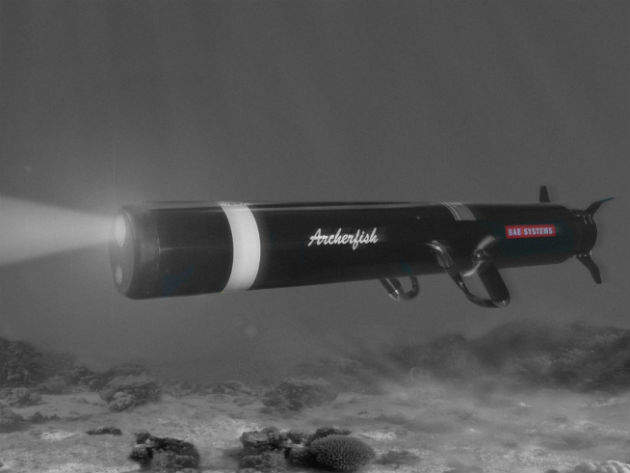

Since 1945, the US Navy alone has suffered a larger number of lost or damaged vessels as a result of mines than from all other weapons combined, while the potential disruption that even the threat of their use in shipping lanes might bring to world trade could severely dent the global economy. Viewed as an essential element of naval warfare in Russian and Chinese doctrine, and with cheaper, expedient versions now easily within reach of any number of militant non-state actors, the sea mine is anything but yesterday’s weapon.
Fortunately, however, there are some very up-to-the-minute solutions to deal with the modern threat, including highly effective unmanned mine counter measures (MCMs) such as Archerfish, a sophisticated, state-of-the-art, mine-hunting drone from BAE Systems.
Archerfish
Described as an expendable mine neutralizer or single shot mine disposal system, Archerfish is a cable-guided, remotely-operated underwater vehicle (ROUV), which can be launched and controlled from a surface ship, from a larger unmanned underwater vehicle (UUV) or – unlike some other systems of this type – from a helicopter. It is deployed via a purpose-built launch cradle and uses a fibre-optic data cable to provide its remotely located operator with full command and control capabilities, and transmit information back from its on-board high-frequency sonar and low-light video sensors to enable mine threats to be identified.
Equipped with twin propulsors, Archerfish uses a fast ‘transit’ mode to move swiftly from its cradle to the suspect object, and then switches to a slow speed ‘hover’ mode as it approaches the target to allow it to take pictures and stream live video to enable its human operator to determine the nature of the threat.
This drive system helps give the ROUV excellent manoeuvring capabilities which enable the pilot to move it very precisely into place alongside the mine in preparation for its disposal. Archerfish contains a directed energy warhead, and once the target has been positively identified for destruction, the operator instructs it to fire its shaped charge, blowing itself up and detonating the mine. According to BAE, integrating the warhead and the package in this way brings logistical benefits, reduced through life cost and overall clearance times are lowered by a factor of four.
“Archerfish both detects and destroys mines. Other underwater ROVs are used either to hunt mines or to destroy. Archerfish, by doing both, is both cost efficient and takes less time to clear sea mines,” explains Emma Judd, external communications manager for BAE Systems Maritime Services.
Modern threat, modern solution
More than 100 years on from the Russo-Japanese war, the technology behind naval mines has moved on from the classic design of a spike covered ball that detonates on contact with a vessel’s hull, which was perfected – and extensively used – by the Tsar’s navy during that conflict. A century of development has made mines increasingly resistant to traditional MCMs and methods of disposal, and Archerfish is specifically designed to counter the particular threat posed by these latest generations of naval mines, as well as remaining equally effective against older types too.
Modern naval mines now use a range of triggering mechanisms and can be set off by a number of different stimuli, including the sound of a ship’s propellers, the pressure of its wake or the magnetic field it generates. ‘Smart’ mines can be set to select particular targets, or to remain hidden from conventional MCM techniques, only to arm themselves once the mine sweeping activity has ceased, while ‘stealthy’ mines are made in shapes, and from materials, which reduce their sonar signature. Other types take a more active approach, such as ‘rising’ mines that launch torpedoes, while some reported to be under development in China will be able to fire sea-to-air missiles to attack low-flying MCM helicopters.
American Archers
Alongside these developments in design, operation and activation, the growing use of insensitive munitions by many nations has implications for the detection and safe disposal of modern sea mines, and has led to something of a boom in new MCM development.
In the US, counter-mine warfare capability assumed renewed priority after the First Gulf War, when US Marines were met with tens of thousands of underwater mines laid along the shoreline of Kuwait by Iraqi forces ahead of their arrival. In the wake of this, the Navy established what it describes as “a requirement for rapid neutralization of bottom and moored sea mines to support operations in littoral zones, confined straits, choke points, and the Amphibious Objective Area.”
The Navy’s Airborne Mine Neutralization System (AMNS) emerged from this, with BAE’s Archerfish selected in 2003 to form the ‘neutralizer’ element of the package. This in turn led to a £15.5m contract for BAE Systems, which was announced in April of this year. If the US Department of Defense subsequently decides to exercise the further options included in that contract, the final total value could be more than £39m.
Airborne Neutralization
Designed to neutralize moored and bottom mines, the AMNS uses sea- or land-based Sikorsky SH-60 ‘Sea Hawk’ helicopters as its central operating platform, helping take the man out of the minefield, and make effective clearance and disposal much safer.
The AMNS itself consists of two major subsystems: the Archerfish ‘Neutralizer’ and a Launch and Handling System (LHS), which has been developed for the system by Raytheon. According to Navy sources, the LHS comprises all the necessary hardware and software for data processing during an AMNS mission, manages the neutralizers during helicopter transit and launch phases, and provides their communications interface. Up to four Archerfish can be carried on any given mission, with each able to be deployed individually as required, without the need to recover the LHS.
The real Archerfish – Toxotes – are renowned for their ability to shoot down insects from vegetation overhanging the surface, using jets of water from their specially shaped mouths. Small, stealthy and uncompromisingly accurate, it seems BAE has chosen the perfect role model for their modern MCM system.







